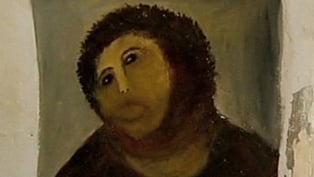
As reported by the Daily Beast, "Was Jesus Lily-White? Author Edward Blum Discusses Race and the Mormon Religion," by Jamie Reno, on 27 July 2012 -- Here’s why you won’t hear Mitt Romney talking about Jesus’s skin color. Jamie Reno discusses race and the Mormon religion with author Edward Blum.
Talk about playing the race card!
Edward Blum, a history professor and religious scholar at San Diego State University and co-author of the forthcoming book The Color of Christ: The Son of God and the Saga of Race in America, isn’t just playing that card, he’s playing with fire with his potentially incendiary thoughts on the current presidential campaign and race—specifically, the race of Jesus Christ.
Yes, you read that right. Who knew that Jesus' skin color was a hot campaign issue this year?

Well, it is, if subconsciously, insists Blum, who says that while neither President Barack Obama nor former governor Mitt Romney has said anything about whether Jesus was white, black, or any other color, there’s a strong if unspoken intersecting narrative of race and religion that greatly defines this election.
In the 2008 presidential race, the words of Rev. Jeremiah Wright, Obama's former preacher, about a black Jesus being killed by white Romans, caused a firestorm of controversy and almost destroyed Obama's campaign.
Those hostilities still linger among many white conservative Christians, says Blum. But, he says, there has been little if any questioning in this campaign of the Church of Jesus Christ of Latter-Day Saints’ approach to what Jesus looked like.
Most, if not all, scientists and theologians now agree that Jesus was likely neither the black man espoused by Obama's former longtime church nor the tall, blue-eyed white man of Romney’s lifelong church.
Back in 2000, a cover story in Popular Mechanics, of all publications, titled “The Real Face of Jesus,” sought scientific answers to this ancient question. With the help of Israeli and British forensic anthropologists and computer programmers, the magazine concluded that Jesus probably had a broad peasant's face, dark olive skin, short curly hair, and a prominent nose. And, the researchers concluded, he would have been 5-foot-1 and weighed 110 pounds.

Blum says that while most Western people have historically viewed Jesus as white, Mormons were some of the first Americans to claim to have seen him and describe him with light hair and blue eyes. “It has simply been overlooked just how ‘white’ the Mormon Jesus really is,” Blum says.
The color of Christ became an especially contentious issue during the civil rights movement in the late 1950s and throughout the 1960s. That’s when African-Americans began to challenge the widely held notion in America that Jesus was a white man.
In 1957, Martin Luther King Jr. received a letter to his syndicated “Advice for Living” question-and-answer column in which the writer asked, “Why did God make Jesus white, when the majority of peoples in the world are non-white?”

King replied that Jesus’s skin color was of little or no consequence but said that Jesus "is no less significant because his skin was white," which in other words meant that King was at the time sticking to the public's notion of a white Jesus. King’s response didn't sit well with some of his African American readers. One of them wrote, “I believe, as you do, that skin color shouldn’t be important, but I don’t believe Jesus was white."
During the civil rights movement, Blum says, Mormons, in a symbolic gesture, placed an 11-foot, lily-white statue of Jesus at the center of Salt Lake City. Dubbed Christus, images of the statue can be found to this day in Mormon welcome centers across the nation, Blum says. Here's a 2008 campaign depicting Romney and Christus: http://bit.ly/M7zYao.
Blum says Christus became an even more significant symbol after 1978, when Mormon leadership lifted its ban of blacks from the priesthood.

“The statue was and remains an icon of white supremacy,” says Blum, who cowrote his book with Paul Harvey, a history professor and author.
Blum says Mormons also used new art forms in the 1960s to display a “very white Jesus” in their homes, temples, and welcome centers. “In this way,” Blum says, “they could uphold their connection to whiteness without having to speak it or legislate it."
In 1969, Blum says, John Scott painted his Jesus Christ Visits the Americas, which featured Jesus with blond hair and fair skin, showing his wounded hands to Anglo-looking Native Americans. “This depiction of the white Jesus and his relationship to white Native Americans became very popular,” Blum says. “Mormon leadership had it featured in The Book of Mormon they put in hotel rooms.”
So what does Blum think Obama would say if he were asked if Jesus were black? And what does he think Romney would say if he were asked if Jesus were white?
“I think Obama would say that the United States is too diverse for any one color to be recognized as the color of Christ or God,” he says. “Obama has stressed that the Golden Rule is his main political lesson from Jesus. I rarely hear Romney mention the Golden Rule in his political positions.”
Blum believes Romney would have a harder time with the question of Jesus’ skin color. “The problem with this question would be intense for Romney because God has a body in Mormon theology, just as humans do,” Blum says. “God and his son Jesus are described as white by the Mormon prophets and in the paintings.” (source: The Daily Beast)


No comments:
Post a Comment